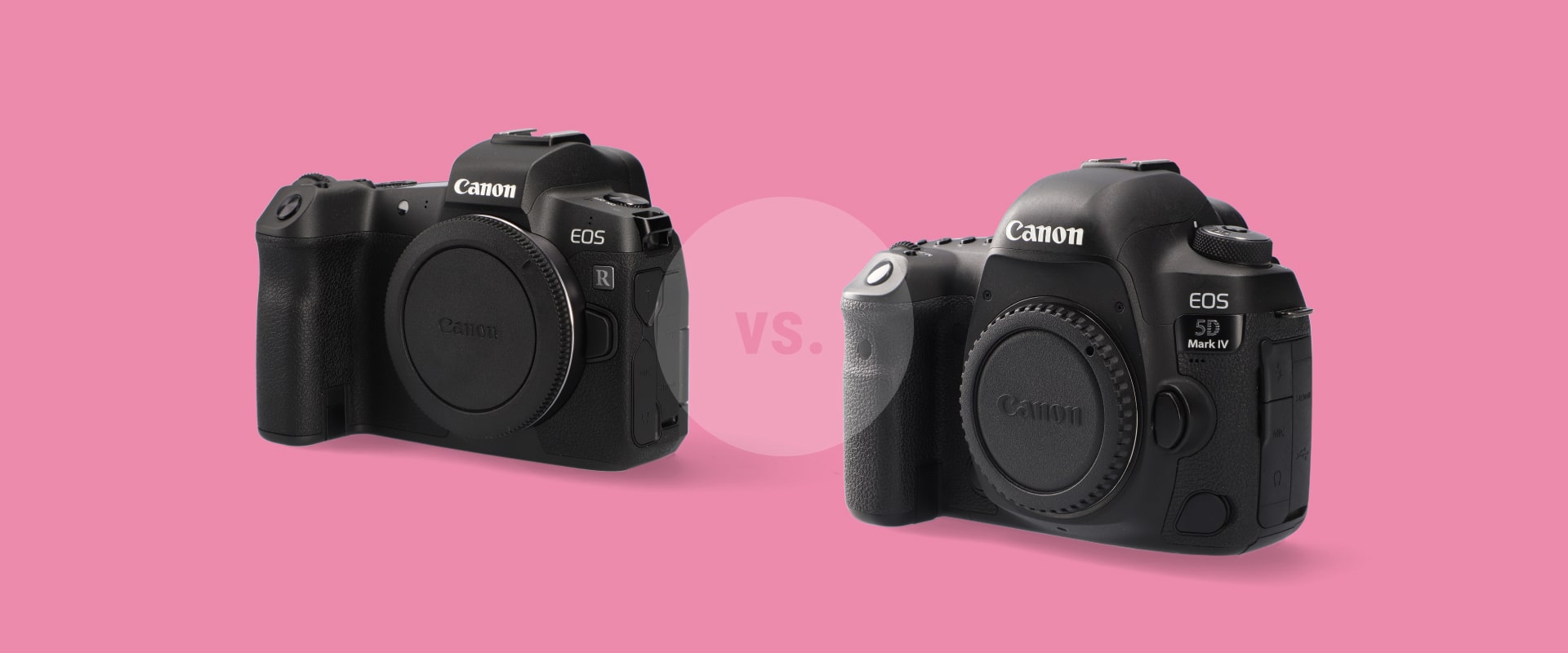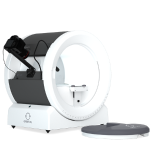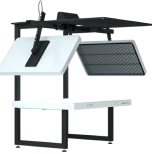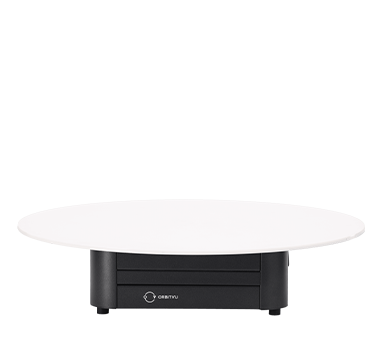Mirror vs. Mirrorless Camera - which is a better product photography camera?
In recent years, we have all experienced the hype and the debate that the appearance of mirrorless cameras has sparked. You may be wondering “where do I find myself in this mess of arguments?”. Or you may still stick to your old and well-exercised habits and exclude the new mirrorless option at all. We are here with our argument-packed guide to help you decide which camera you need for product photography: DSLR or mirrorless?
Mirror vs. Mirrorless Camera - Which is a Better Product Photography Camera?
To answer this question, we might need to move back in time to 1969, when image was first registered digitally on a sensor. This was achieved by Willard S. Boyle and George E. Smith, and in 1975 Steven Sasson from Kodak created the first digital camera. However, it took nearly 30 years to build a full-frame digital camera and even more for the idea to dominate the market. In 2002, the Contax N Digital was released, beginning the era of consumer-available digital SLRs.

Why do we get so deep into history? This is because, although equipment changes over the years, human habits remain quite stable. The first years of DSLRs were not easy and these cameras were slowly gaining in popularity. Photographers had to make out a more stable conviction that it is OK to use digital. Of course, the development of the technology helped significantly. This suggests that the same schema can be applied to the appearance of mirrorless cameras.
History likes to go in circles, and we firmly believe that this will be the case with mirrorless solutions in photography. Since their coming into the market, they have steadily won trust and proven reliability.
But what exactly is the difference between a DSLR and a mirrorless camera? Is it a revolutionary change or merely a slight modification in construction? We help to find the devil in the details.
What is the difference, and is mirrorless better than DSLR?
We might joke that DSLRs are simply more complicated than their mirrorless counterparts. Does this lead to more efficient and reliable photography results? We will examine this in the further parts of the guide. First, let’s see how these two camera systems are built.
DSLR construction
The main difference, one that causes the intensive debate, lies in the construction of the camera system. A DSLR, which means Digital Single Lens Reflex camera, has a physical reflex mirror and a viewfinder prism built into the optical system.

Source and copyright: Canon Europe

Source and copyright: Canon Europe
Their role is to pass the image from the lens into the optical viewfinder at the top of the product photography camera. The mirror blocks the access of light to the digital sensor and redirects it up towards the viewfinder. The moment the shutter is released, the mirror flips making space for the light to fall onto the sensor.
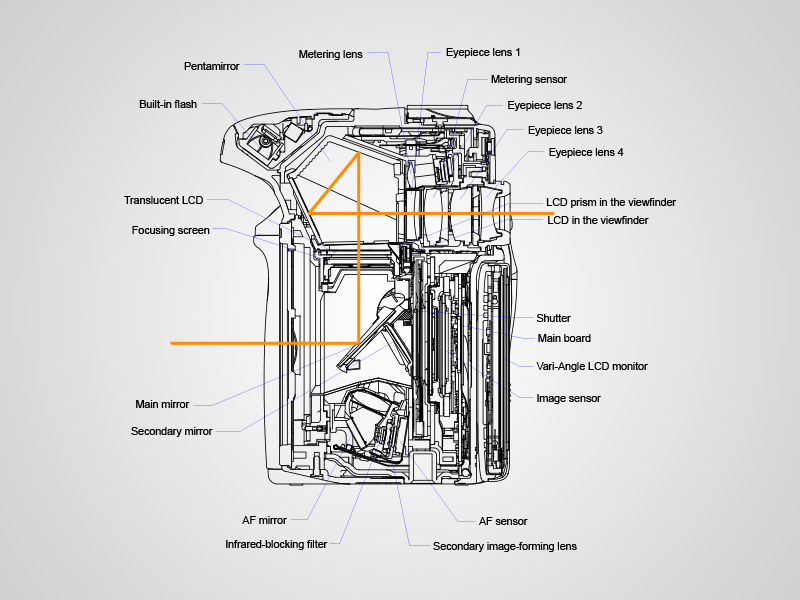
Thus, in DSLRs we were viewing what the lens sees, which was nominally different from the image the sensor received. To make things more complicated, a DSLR would have another, smaller mirror that directs the light into the autofocus system. It happens simultaneously with passing the light to the viewfinder. This smaller mirror is placed behind the main one and is able to receive light due to the semi-transparent construction of the bigger mirror (see the details in the article on pellicle mirror).

Mirrorless camera construction
A mirrorless camera, which is as good a category name as Compact System Camera (CSC), has a physically simpler construction.
The light from the lens falls directly onto the sensor. There is no need for a reflex mirror and for a separate autofocus system. The AF is based on the sensor image, which can in fact make it faster.
If a mirrorless camera has a viewfinder, it is necessarily an electronic solution which transmits the image from the sensor. This can be compared to a television-watching experience.
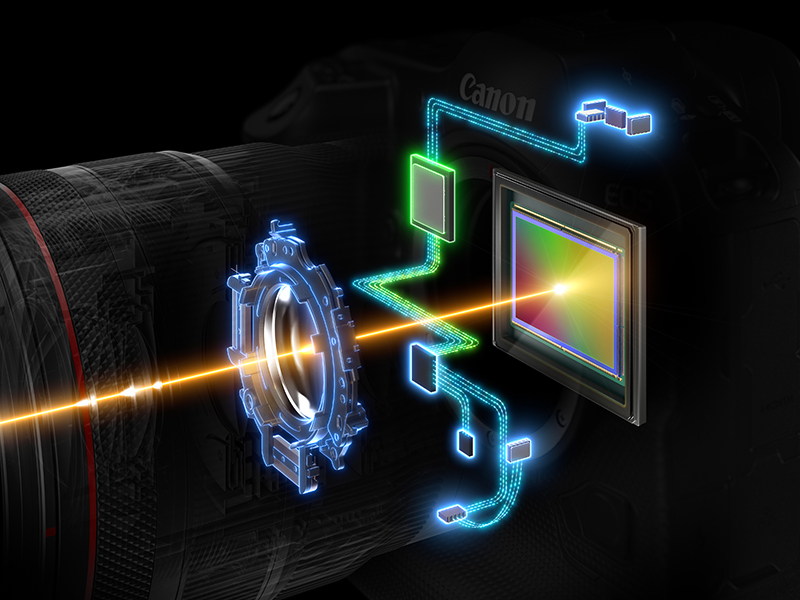
Light on a sensor Source and copyright: Canon Europe
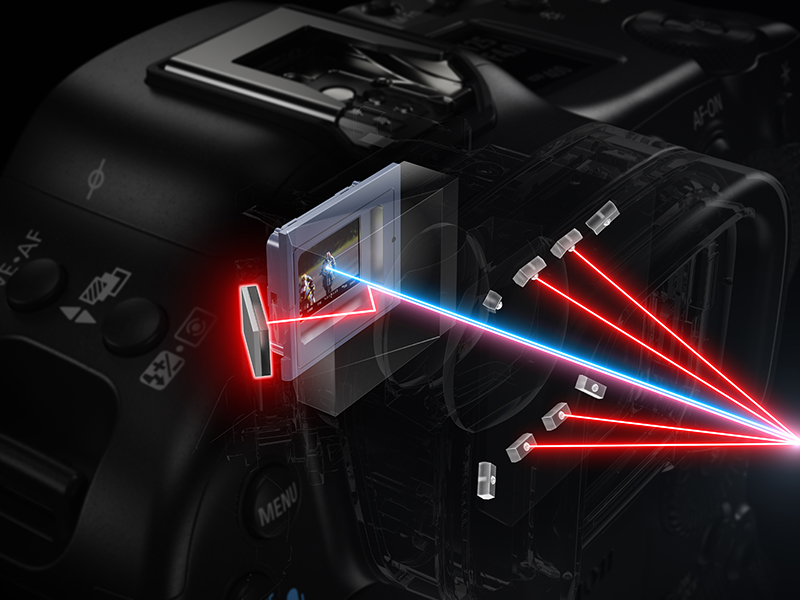
Light on a viewfinder Source and copyright: Canon Europe
The relative simplicity of a mirrorless camera construction has its advantages and disadvantages. Let’s have a look at them one by one.
Optical vs electronic viewfinder
As we have already demonstrated, mirrorless cameras rely on electronic viewfinders (EVF). What is displayed on the EVF is not exactly the optical image that the lens can see, rather a digitally reworked image from the sensor.
The difference is clearly visible for the user’s eye, especially in lower mirrorless models, where lower resolutions are used for electronic viewfinders. The flagship models reduce this at first dissatisfying experience by using OLED displays of high quality and image fluidity. The eye and your brain will eventually get used to the different characteristics of the image.

Electronic viewfinder
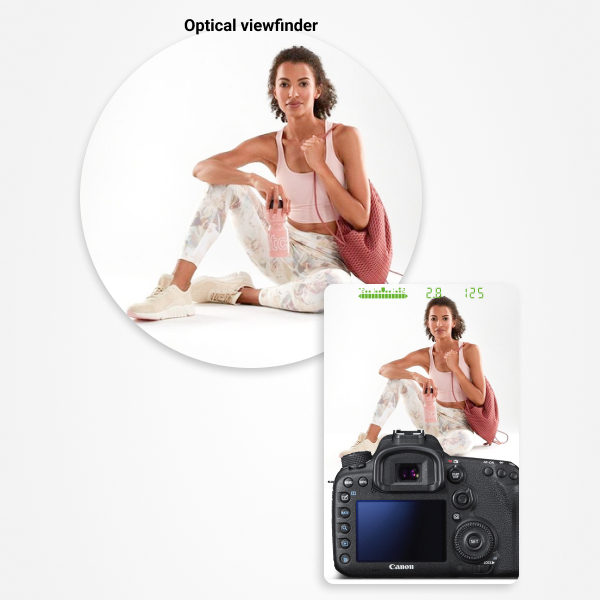
Optical viewfinder
Live view of the photographed scene
As an advantage of electronic viewfinders, we can take the fact that they display what the sensor receives, and thus bring the user closer to actually seeing the final photo.
This is best illustrated by taking an example of a photograph taken on a sunny day. If our camera settings cause the image to be overexposed due to high amounts of light, the user will not see it in the optical viewfinder. An inbuilt light meter is necessary to mark the issue. At the same time, an electronic viewfinder will show the overexposed image right as the sensor receives it, paving a quicker way to camera settings correction.
Image fluidity
In the construction of the electronic viewfinder sits the potential disadvantage of this solution. It may lack fluidity, as between the eye and the light there exists a whole electronic system of image processing. This is not the case with the optical viewfinder. The milliseconds lost on the “electronic way” can cause an experience of viewing discomfort, especially with objects moving at high speeds.
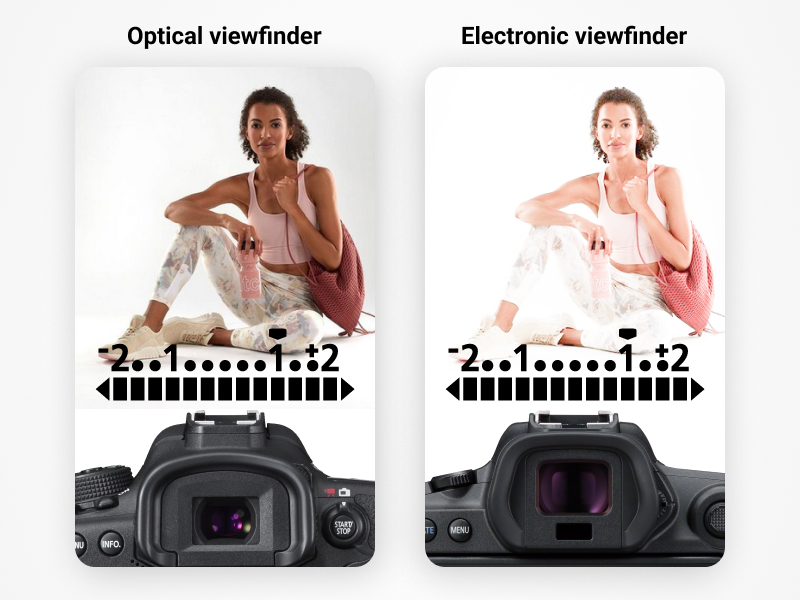
Advantages and disadvantages in product photography
The difference between the viewfinder experience in DSLRs and mirrorless cameras has been a major deterring factor for the market development of mirrorless solutions. The fluidity of the viewfinder being of rather secondary importance in product photography (the products are still!), we may easily say that this one factor will not be key for your choice and may speak in favor of a CSC.
The same can be said for shooting a video. The mirror in a DSLR is flipped during the process, disabling the optical viewfinder and leaving the user with an electronic back-of-the-device solution. For product videos, all the ergonomy advantages of mirrorless cameras will speak stronger.
Camera body & ergonomics
In the DSLR vs mirrorless comparison, an important role is played by the size of the camera body, which carries a series of ergonomy implications.
Do you need a smaller camera body?
Due to its simpler construction, a mirrorless model can be smaller. The body does not need to house two mirrors and a prism. As a consequence, most mirrorless cameras will be visibly smaller than DSLRs. For outdoor and personal use photography this is a serious advantage. Users carry only light bodies, which are more portable and lighter.

Mirrorless body
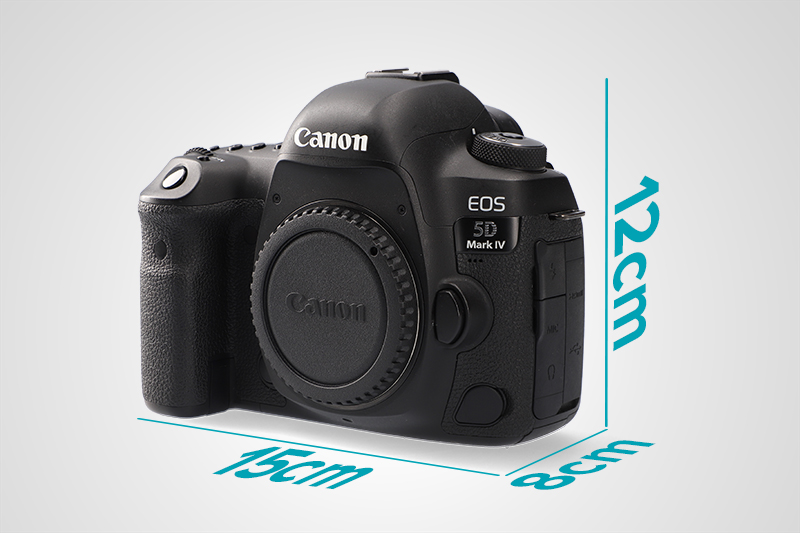
DSLR body
What about battery life?
The smaller size of the camera body, however, means that only a smaller battery of lower capacity fits into the system. With the additional stress put on the battery due to the use of electronic displays, this can grow to a serious disadvantage.
To illustrate the question of battery ergonomics, let’s have a look at the example of two Canon cameras. At the temperature of 23° C, the battery of the DSLR Canon EOS 5D mk IV holds up to 900 photos. The mirrorless R5 model, using the LCD display, takes only 490 photos on one battery charge.
Canon mirrorless cameras have not undergone a serious minimization of the body, being similar in size to the earlier DSLRs with a smaller APS-C sensor. On the contrary, Sony has invested a lot in smaller body sizes for their mirrorless cameras. Let’s compare two competitive models:
Canon R5: 138,5 × 97,5 × 88 mm
Sony A7 RIV: 128,9 mm × 96,4 mm × 77,5 mm
Camera size in product photography
For those wishing for firmer grip on mirrorless cameras, there is a whole line of additional grips and battery grips, which can help minimize the effects of a smaller body.
In product photography, which is mostly done in indoor studios, this difference again plays a smaller role. Using tripods and AC camera power in fact remove the importance of size and portability. Is this another call for mirrorless options?
DSLR vs mirrorless – which one is quicker?
Traditional DSLRs and SLRs are equipped with a mechanical shutter, which is a physical mechanism that orchestrates the time of light exposure of the sensor. It consists of two covers that work together in the opening of the lens to limit the amount of light by opening and closing the access to the sensor area. This kind of shutter has its speed limitations and is loud enough to disrupt photography at public events.
Recent technology development has led to the introduction of the electronic shutter, which was applied both in DSLRs and mirrorless cameras. What is the electronic shutter and how does it influence the speeds a camera can achieve?
Try the electronic shutter – a world of possibilities.
An electronic shutter works as a digital mechanism that reads rows of pixels on the sensor in a time set by the user with the choice of shutter speed. No physical covers are needed, as all is exercised digitally.
This brings a number of advantages that the electronic shutter-equipped mirrorless cameras offer:
- Ultra-high shutter speeds. This is advantageous for movement photography, to be applied when shooting sports & nature.
- Low depth-of-field in any conditions. High shutter speeds allow you to work with low apertures, enabling blurred background even when the strong light is unencouraging. Forget about the grey filter!
- Silent operation. Perfect for musical events photography and situations when the click is simply seen as inelegant.
No vibration at the release of the shutter. This may be important for longer exposure times. No camera shake and full sharpness made available!

The above list shows that mirrorless cameras tend to offer a wider range of possibilities for difficult outdoor conditions. With product photography, their impact is limited, as only rarely will you aim for lower apertures and the click sound will not disturb the work of the studio.
Autofocus in DSLR and mirrorless cameras for product photography
With autofocus, we arrive at one of the key factors that may speak towards the choice of a mirrorless camera over a DSLR. The secret of the AF precision and speed lies in the construction of the system and its digitalization.
The bonus that comes with mirrorless autofocus
The autofocus of mirrorless cameras is realized through the digital sensor itself. The AF mirror has been eliminated and replaced with a fully digital measurement mechanism. The differences that go with the improvement can be listed as follows:
- The speed of the AF is dependent on electronics only. There is no physical element to the AF system such as the mirror.
- The number of AF fields is significantly increased. High-end DLSRs used to have 61 AF points (Canon 5D Mk IV) while mirrorless cameras can reach up to 5000 points (Canon R5). You can catch focus more precisely and in the whole frame indeed.
- Mirrorless cameras do not have AF limitations with the Live View on. In DSLRs, when the mirror was flipped (video shooting and Live View), the standard AF system did not work, relying on a supplementary one. In mirrorless cameras, there is one system only and no difference in speeds at Live View.
- The sensor-based AF has access to ISO and view in the dark. The digital solution to AF simulates exposition and works better in the darkness, without the need to operate additional light.
Face and eye-recognition systems work better with the digital-based AF. This is an after-effect of the constant access to exposition simulation and better operation in the darkness.
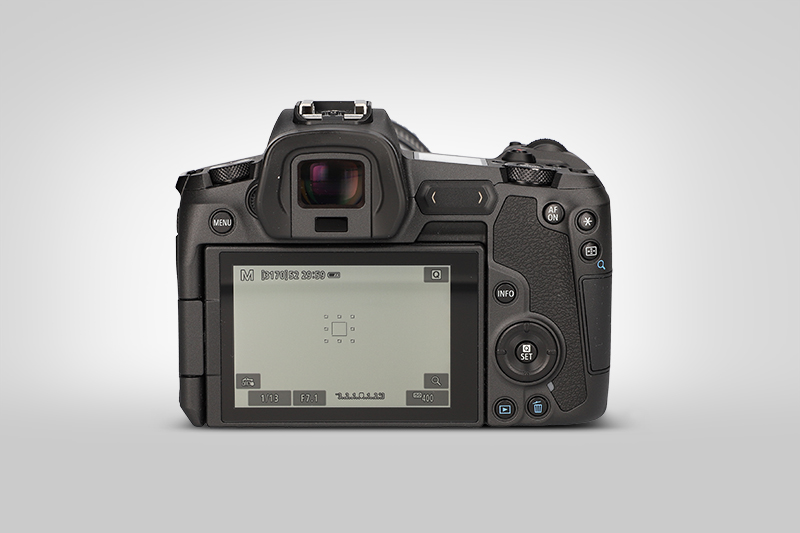
Phase detection and contrast detection AF
To explain in detail the work of autofocus in DSLRs and mirrorless cameras, we will need to mention two ways in which the AF achieves focus. The first one is called phase detection and is based on measuring the distance between the object and the camera. It is used via a separate AF system in DSLRs and guarantees very precise focus.
The other AF method is called contrast detection and works based on differences between dark and light areas of the image. It functions on the sensor itself and offers worse focus quality. Mirrorless cameras use a combination of both methods, which takes them to a new level of focus effectiveness.
Canon has developed a system, the Dual Pixel CMOS, which allows for phase detection focusing on the digital sensor (not in a separate system) and where the subject is recognized not only for its distance from the camera but also for the direction in which it moves. Expect to find this solution in higher end mirrorless cameras and some Canon EOS models, such as the EOS 80D, the Cinema line and the advanced EOS 7D.

AF for product photography – a conclusion
Autofocus does not need to be quick or more sensitive in product photography. The bonus you get sits in the possibility to catch focus on virtually any point of the product. Still, this points us towards a modest conclusion that mirrorless cameras do not introduce a revolutionary improvement to the product photographer’s life. They may be a bonus for their universality, however, the daily studio work will not use all of their AF capabilities.
Lenses
In the first years of mirrorless cameras, their interchangeable lenses repertoire on the market was rather limited. At the end of 2021, the market offer is much wider and in fact the disadvantage of mirrorless solutions in the choice of optics has been eliminated.
For your product photography needs, all the rules in lens choice apply, as we outlined them in our dedicated article. Aim for high-end lenses and remember that no serious zooming capabilities will be of use.
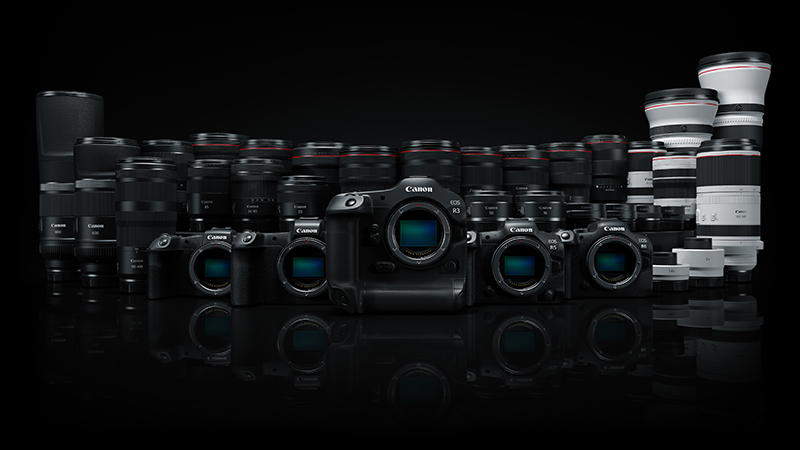
Facts and myths about camera choice
In the final section, we aim to dispel several myths surrounding the DSLR vs mirrorless choice. Our questions and answers will serve to bring you closer to your own decision and finally demonstrate that the mirrorless debate is already settled. Mirrorless cameras will be with us for good.
Are mirrorless cameras better than DSLR?
Mirrorless technology has progressed from a relative novelty to a standard offer on the market. The decision which solution is better is multifaceted and largely depends on the use you are going to have for your camera.
The viewfinder, the ergonomy, the shutter, and the autofocus will remain the key points to keep in mind when approaching a DSLR vs mirrorless decision.
In the above paragraphs we tried to carefully describe the differences between traditional DSLRs and mirrorless cameras with an indication how they might serve in product photography.
Many mirrorless cameras, considering their price range, could turn out a tempting option for a product photography studio. But we may as well say that old habits do not necessarily wane so quickly and a DSLR might be more ergonomically satisfying.

Do professionals use DSLR or mirrorless?
There is no good answer to whether a professional should use a mirror vs mirrorless camera. Mirrorless cameras are simply a newer technology that is gaining in popularity thanks to its advancement. More and more professionals will decide to switch from DSLR to mirrorless in the coming years.
Will mirrorless cameras replace DSLR?
The chance that both DLSRs and mirrorless cameras will survive the debate and remain competitive offers in the market is rather lower than higher. The mirrorless debate will find more answers with technology development in the department of battery powering and digital sensor construction. The expansion of mirrorless options remains a stable trend and most probably will lead old DSLRs to the shadows of history.
Is the sensor smaller in mirrorless cameras?
The size of the sensor does not depend on the mirror or mirrorless technology used in the camera for product photography. You can buy a mirrorless camera with an APS-C sensor and a full frame camera as well. Everything depends on the model and producer.
Do entry level mirrorless cameras falsify the image?
The faithfulness of image is the same in all mirrorless and DSLR cameras. They process the image in the same way, via a digital sensor.
Are mirrorless cameras only a momentary trend?
Nope, the technology used in mirrorless cameras is usually more advanced than in older DSLRs. This is a trend to stay and soon rule the market.
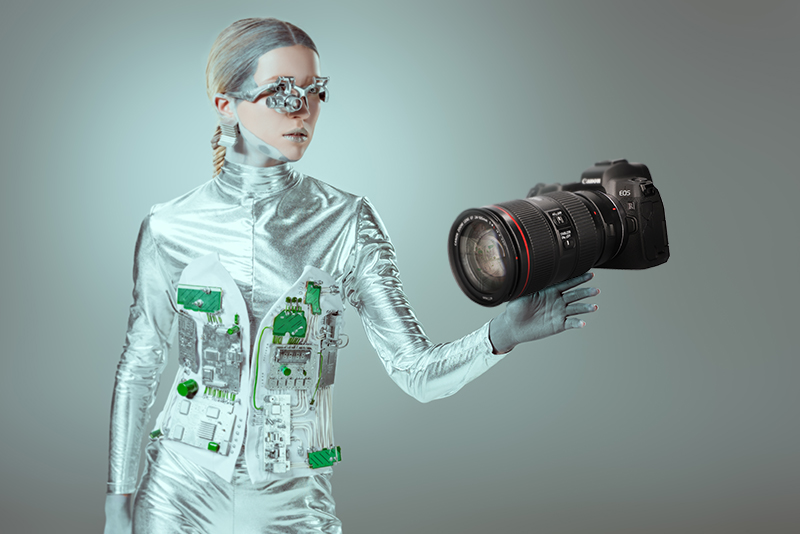
Conclusion
So the debate is on! Armed with serious arguments supporting both sides, you will be able to make a reasonable decision depending on your needs and possibilities.
It is sure that mirrorless cameras will feature more and more in most photography branches and soon the question will rather be “which mirrorless camera to choose?”. At the same time, a sentiment remains for the good old shutter click of a DSLR.
Do not let irrational arguments that abound in the DSLR vs mirrorless debate influence your product photography too much. We wish you a clear mind and an effective, ergonomic camera experience on your way.
Stay tuned!
Contact us
Contact us
Got questions? We'd love to hear from you. Send us a message and we will respond as soon as possible
Products
Products
Articles you may also like
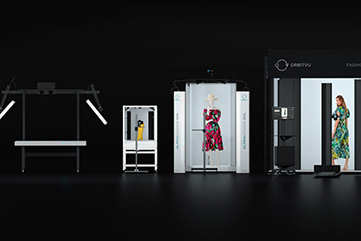
Our USA operations are expanding! Join us for our Virtual Open House Thursday 23 June, 2022, 10am & 2pm EDT

Glass is beauty put in a simple item. Just as glass inspires artists and makes our homes beautiful, photographing glassware i...

The Orbitvu SUN Cloud gets a handy upgrade in user experience with the launch of new functionalities and an overhauled menu. ...






